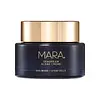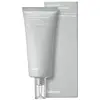What's inside
What's inside
 Key Ingredients
Key Ingredients

 Benefits
Benefits

 Concerns
Concerns

 Ingredients Side-by-side
Ingredients Side-by-side

Palmaria Palmata Extract
Skin ProtectingWater
Skin ConditioningRicinus Communis Seed Oil
MaskingTheobroma Grandiflorum Seed Butter
Skin ConditioningPentylene Glycol
Skin ConditioningCetearyl Alcohol
EmollientGlycerin
HumectantGlyceryl Stearate
EmollientCetearyl Olivate
Citrullus Lanatus Seed Oil
EmollientMoringa Oleifera Seed Oil
EmollientGlyceryl Caprylate
EmollientSorbitan Olivate
EmulsifyingSqualane
EmollientSodium Gluconate
Skin ConditioningSodium Lactate
BufferingCetyl Hydroxyethylcellulose
Emulsion StabilisingMaris Aqua
HumectantSodium Stearoyl Glutamate
CleansingKappaphycus Alvarezii Extract
Skin ConditioningCaprylic/Capric Triglyceride
MaskingCaprylhydroxamic Acid
Eclipta Prostrata Extract
Skin ConditioningLimnanthes Alba Seed Oil
Skin ConditioningVaccinium Myrtillus Seed Oil
Skin ConditioningOenothera Biennis Oil
EmollientCrambe Abyssinica Seed Oil
Skin ConditioningAdansonia Digitata Seed Oil
EmollientMalus Domestica Fruit Cell Culture Extract
Skin ConditioningVitis Vinifera Seed Oil
EmollientSodium Phytate
Sodium PCA
HumectantLecithin
EmollientBenzoic Acid
MaskingHydrolyzed Pinus Sibirica Seedcake Extract
Skin ConditioningGigartina Stellata Extract
Skin ProtectingChondrus Crispus Extract
Skin ConditioningSodium Nitrate
SoothingXanthan Gum
EmulsifyingCystoseira Tamariscifolia Extract
Skin ConditioningHydrated Silica
AbrasiveAlaria Esculenta Extract
Skin ProtectingSodium Benzoate
MaskingAcanthopanax Senticosus Root Extract
Skin ConditioningDisodium Phosphate
BufferingTocopherol
AntioxidantSilica Dimethyl Silylate
EmollientSodium Phosphate
BufferingPotassium Sorbate
PreservativeSodium Hydroxide
BufferingPalmaria Palmata Extract, Water, Ricinus Communis Seed Oil, Theobroma Grandiflorum Seed Butter, Pentylene Glycol, Cetearyl Alcohol, Glycerin, Glyceryl Stearate, Cetearyl Olivate, Citrullus Lanatus Seed Oil, Moringa Oleifera Seed Oil, Glyceryl Caprylate, Sorbitan Olivate, Squalane, Sodium Gluconate, Sodium Lactate, Cetyl Hydroxyethylcellulose, Maris Aqua, Sodium Stearoyl Glutamate, Kappaphycus Alvarezii Extract, Caprylic/Capric Triglyceride, Caprylhydroxamic Acid, Eclipta Prostrata Extract, Limnanthes Alba Seed Oil, Vaccinium Myrtillus Seed Oil, Oenothera Biennis Oil, Crambe Abyssinica Seed Oil, Adansonia Digitata Seed Oil, Malus Domestica Fruit Cell Culture Extract, Vitis Vinifera Seed Oil, Sodium Phytate, Sodium PCA, Lecithin, Benzoic Acid, Hydrolyzed Pinus Sibirica Seedcake Extract, Gigartina Stellata Extract, Chondrus Crispus Extract, Sodium Nitrate, Xanthan Gum, Cystoseira Tamariscifolia Extract, Hydrated Silica, Alaria Esculenta Extract, Sodium Benzoate, Acanthopanax Senticosus Root Extract, Disodium Phosphate, Tocopherol, Silica Dimethyl Silylate, Sodium Phosphate, Potassium Sorbate, Sodium Hydroxide
Water
Skin ConditioningGlycerin
HumectantCaprylic/Capric Triglyceride
MaskingButylene Glycol
HumectantPropanediol
SolventStearic Acid
CleansingCetearyl Alcohol
EmollientMethyl Trimethicone
Skin ConditioningCaprylyl Methicone
Skin Conditioning1,2-Hexanediol
Skin ConditioningC12-16 Alcohols
EmollientPanthenol
Skin ConditioningOlea Europaea Fruit Oil
MaskingDipropylene Glycol
HumectantAllantoin
Skin ConditioningPantolactone
HumectantMalt Extract
Skin ProtectingCeramide EOP
Skin ConditioningCeramide Ns
Skin ConditioningCeramide NP
Skin ConditioningCeramide As
Skin ConditioningCeramide AP
Skin ConditioningSodium Hyaluronate
HumectantHeptasodium Hexacarboxymethyl Dipeptide-12
Skin ConditioningPhytosphingosine
Skin ConditioningArachidic Acid
CleansingOleic Acid
EmollientPalmitic Acid
EmollientGlyceryl Stearate Se
EmulsifyingHydrogenated Lecithin
EmulsifyingXanthan Gum
EmulsifyingCarbomer
Emulsion StabilisingGlucose
HumectantCetearyl Glucoside
EmulsifyingEthylhexylglycerin
Skin ConditioningCholesterol
EmollientTocopherol
AntioxidantTromethamine
BufferingDisodium EDTA
Water, Glycerin, Caprylic/Capric Triglyceride, Butylene Glycol, Propanediol, Stearic Acid, Cetearyl Alcohol, Methyl Trimethicone, Caprylyl Methicone, 1,2-Hexanediol, C12-16 Alcohols, Panthenol, Olea Europaea Fruit Oil, Dipropylene Glycol, Allantoin, Pantolactone, Malt Extract, Ceramide EOP, Ceramide Ns, Ceramide NP, Ceramide As, Ceramide AP, Sodium Hyaluronate, Heptasodium Hexacarboxymethyl Dipeptide-12, Phytosphingosine, Arachidic Acid, Oleic Acid, Palmitic Acid, Glyceryl Stearate Se, Hydrogenated Lecithin, Xanthan Gum, Carbomer, Glucose, Cetearyl Glucoside, Ethylhexylglycerin, Cholesterol, Tocopherol, Tromethamine, Disodium EDTA
 Reviews
Reviews

Ingredients Explained
These ingredients are found in both products.
Ingredients higher up in an ingredient list are typically present in a larger amount.
This ingredient is an emollient, solvent, and texture enhancer. It is considered a skin-softener by helping the skin prevent moisture loss.
It helps thicken a product's formula and makes it easier to spread by dissolving clumping compounds.
Caprylic Triglyceride is made by combining glycerin with coconut oil, forming a clear liquid.
While there is an assumption Caprylic Triglyceride can clog pores due to it being derived from coconut oil, there is no research supporting this.
Learn more about Caprylic/Capric TriglycerideCetearyl alcohol is a mixture of two fatty alcohols: cetyl alcohol and stearyl alcohol. It is mainly used as an emulsifier. Emulsifiers help prevent the separation of oils and products. Due to its composition, it can also be used to thicken a product or help create foam.
Cetearyl alcohol is an emollient. Emollients help soothe and hydrate the skin by trapping moisture.
Studies show Cetearyl alcohol is non-toxic and non-irritating. The FDA allows products labeled "alcohol-free" to have fatty alcohols.
This ingredient is usually derived from plant oils such as palm, vegetable, or coconut oils. There is debate on whether this ingredient will cause acne.
Due to the fatty acid base, this ingredient may not be Malassezia folliculitis safe.
Learn more about Cetearyl AlcoholGlycerin is already naturally found in your skin. It helps moisturize and protect your skin.
A study from 2016 found glycerin to be more effective as a humectant than AHAs and hyaluronic acid.
As a humectant, it helps the skin stay hydrated by pulling moisture to your skin. The low molecular weight of glycerin allows it to pull moisture into the deeper layers of your skin.
Hydrated skin improves your skin barrier; Your skin barrier helps protect against irritants and bacteria.
Glycerin has also been found to have antimicrobial and antiviral properties. Due to these properties, glycerin is often used in wound and burn treatments.
In cosmetics, glycerin is usually derived from plants such as soybean or palm. However, it can also be sourced from animals, such as tallow or animal fat.
This ingredient is organic, colorless, odorless, and non-toxic.
Glycerin is the name for this ingredient in American English. British English uses Glycerol/Glycerine.
Learn more about GlycerinTocopherol (also known as Vitamin E) is a common antioxidant used to help protect the skin from free-radicals and strengthen the skin barrier. It's also fat soluble - this means our skin is great at absorbing it.
Vitamin E also helps keep your natural skin lipids healthy. Your lipid skin barrier naturally consists of lipids, ceramides, and fatty acids. Vitamin E offers extra protection for your skin’s lipid barrier, keeping your skin healthy and nourished.
Another benefit is a bit of UV protection. Vitamin E helps reduce the damage caused by UVB rays. (It should not replace your sunscreen). Combining it with Vitamin C can decrease sunburned cells and hyperpigmentation after UV exposure.
You might have noticed Vitamin E + C often paired together. This is because it is great at stabilizing Vitamin C. Using the two together helps increase the effectiveness of both ingredients.
There are often claims that Vitamin E can reduce/prevent scarring, but these claims haven't been confirmed by scientific research.
Learn more about TocopherolWater. It's the most common cosmetic ingredient of all. You'll usually see it at the top of ingredient lists, meaning that it makes up the largest part of the product.
So why is it so popular? Water most often acts as a solvent - this means that it helps dissolve other ingredients into the formulation.
You'll also recognize water as that liquid we all need to stay alive. If you see this, drink a glass of water. Stay hydrated!
Learn more about WaterXanthan gum is used as a stabilizer and thickener within cosmetic products. It helps give products a sticky, thick feeling - preventing them from being too runny.
On the technical side of things, xanthan gum is a polysaccharide - a combination consisting of multiple sugar molecules bonded together.
Xanthan gum is a pretty common and great ingredient. It is a natural, non-toxic, non-irritating ingredient that is also commonly used in food products.
Learn more about Xanthan Gum